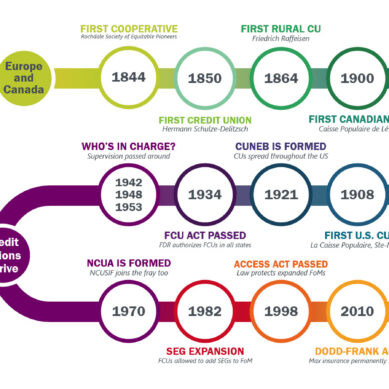The data analyst giving you pushback on your data request isn’t trying to be uncooperative. Data analysts often find themselves asking follow-up questions to draw out the details of a custom report request. As the data analyst at my credit union, I make it my goal to not just provide analysis, but also to educate the team on the toolset available to each of us.
Better to be prepared
Here are some questions to think about before submitting your request, as these are ones the data analyst will likely ask you.
What do you want to know?
Most people think they have done all they need to do by answering this question. Defining what you want and don’t want in the data is a necessary starting point, of course, but only part of what is needed.
Did you know about the available dashboards and prepackaged solutions that can answer many of your data questions?
Do not be surprised if this is one of the first questions asked of you! A custom-tailored suit may not be necessary for you if a perfectly serviceable outfit can be bought off the rack. Successful data analysts are teachers at heart.
When the analyst, in lieu of a custom report, educates you on how you can self-serve with data tools to find the answer, they are still doing their job. You may even come to appreciate not having to wait for someone to get back to you on those simple data requests you can handle yourself. If you and the analyst agree that no pre-existing report meets your needs, a custom report is probably the way to go.
Why do you want to know?
Ask yourself why you need this data. Consider a request like “Give me a list of all the members who are tied to Branch X.” This seems like a clear, straightforward request, but the request’s purpose—the ‘why’—has not been disclosed. If the request is more demographic in nature, such as statistics on the number of members in an area, the data analyst can afford to be more liberal in the data provided.
Contact lists, by contrast, require some data restrictions to be added to prevent contacting the wrong people. No one wants to have conversations like “You people just repoed my car and now you want me to open an account?!” or “Why are you making a sales call to my husband who just passed away?” or “I already told you I don’t want to receive marketing calls.”
This is why data analysts worth their salt never just take people at their word. The request’s purpose makes a difference and knowing it will help you and the analyst avoid pitfalls.
Have you also considered…?
You should always expect a bit of negotiation with every custom report request you make.
For example, you have told the data analyst that this is a contact list of people tied to Branch X. When the analyst asks what you will be contacting them about, you say “Oh, Branch X’s ATMs will be down for maintenance tomorrow, and so we are notifying everyone at Branch X.” Then the analyst might say, “Well, you will probably also want to reach out to our members in the same city or close by who are not tied to Branch X, because they likely use the Branch X ATM and will also be affected.”
That is just one small example of how a data analyst asking good diagnostic questions can help you get it right. Knowing your goals will prompt the analyst to suggest other relevant things to consider.
Will this data make a difference?
Data analysts appreciate assurances that you won’t just “bury the results.” Perhaps you have read accounts of prisoners on a work detail who were forced to dig ditches all day, then were obliged to fill those ditches in at the end of the day. The message to the prisoners was clear: you and your work are meaningless. Everyone wants to know that their work has real value and that it makes a difference.
When making a report request, consider whether the request proceeds from idle curiosity or whether it will result in something actionable you intend to follow up on. Make sure you are prepared to do (or delegate) the work the analyst uncovers for you.
If you ask the analyst to identify miscoded loans, have someone ready to do the maintenance. Little asides like “So-and-so will be making the corrections” or “This data will be used to evaluate the profitability of product Y” help make the expected connection between effort and goal.
Is this request time-sensitive, or can it wait, and for how long can it wait?
Like you and everyone else at the credit union, the data analyst is busy juggling multiple priorities. Knowing details like “This is for the board meeting next Monday and I need to have it by end-of-day Friday” is very helpful—except when it’s already end-of-day Friday and you are just now asking.
Do not make the data analyst the last stop on the way to your critical meeting or presentation. While data analysts can and often do work miracles, having a time cushion is always preferable.
Who is the intended audience or recipient of the data?
Is this important for just one person or does it factor into something bigger? If you plan to pass on what the data analyst gives you, it can make a critical difference in how a report is laid out and presented, and which data is included or excluded.
Data with personally identifying information (PII) may be appropriate for some end users and not for others. Data precision will vary for different audiences, with some expecting exact numbers and others content with ballpark figures.
If the recipient is data savvy, a ‘quick-and-dirty’ report might work, whereas someone without the background knowledge should receive a little more context and explanation to help interpret the report.
From which point in time do you want the data?
Month-end data are fixed, while snapshot data show the status at the time the report was run. Month-end data should allow you to balance to other month-end reports, but with snapshot data, values may change a fraction of a second after the analyst runs the report since the data are typically from a live system where people are doing transactions and maintenance all the time.
Often, the report purpose you have outlined will clearly point to one or the other timeframe as the best solution, but in the event it is not clear or it could go either way, expect to be asked this question.
Over what period of time do you want the data?
Some requests involve questions like: Are you asking for all loans opened year to date, or only those opened last month? Or for all time?
Will you need this data again?
Some requests are one-time affairs, while others are recurring, like every month, week, or day. If you want to see the data on a regular basis, the report will need to be added to a schedule, so it isn’t forgotten.
Have the information ready beforehand
Keeping all these considerations in mind will help you better frame your custom report requests. If you do not nail down every detail ahead of time, the analyst will navigate these questions with you, but they will appreciate the effort you spent in thinking these things through.

























































